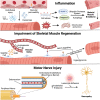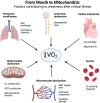The role of the microcirculation and integrative cardiovascular physiology in the pathogenesis of ICU-acquired weakness
- PMID: 37234410
- PMCID: PMC10206327
- DOI: 10.3389/fphys.2023.1170429
The role of the microcirculation and integrative cardiovascular physiology in the pathogenesis of ICU-acquired weakness
Abstract
Skeletal muscle dysfunction after critical illness, defined as ICU-acquired weakness (ICU-AW), is a complex and multifactorial syndrome that contributes significantly to long-term morbidity and reduced quality of life for ICU survivors and caregivers. Historically, research in this field has focused on pathological changes within the muscle itself, without much consideration for their in vivo physiological environment. Skeletal muscle has the widest range of oxygen metabolism of any organ, and regulation of oxygen supply with tissue demand is a fundamental requirement for locomotion and muscle function. During exercise, this process is exquisitely controlled and coordinated by the cardiovascular, respiratory, and autonomic systems, and also within the skeletal muscle microcirculation and mitochondria as the terminal site of oxygen exchange and utilization. This review highlights the potential contribution of the microcirculation and integrative cardiovascular physiology to the pathogenesis of ICU-AW. An overview of skeletal muscle microvascular structure and function is provided, as well as our understanding of microvascular dysfunction during the acute phase of critical illness; whether microvascular dysfunction persists after ICU discharge is currently not known. Molecular mechanisms that regulate crosstalk between endothelial cells and myocytes are discussed, including the role of the microcirculation in skeletal muscle atrophy, oxidative stress, and satellite cell biology. The concept of integrated control of oxygen delivery and utilization during exercise is introduced, with evidence of physiological dysfunction throughout the oxygen delivery pathway - from mouth to mitochondria - causing reduced exercise capacity in patients with chronic disease (e.g., heart failure, COPD). We suggest that objective and perceived weakness after critical illness represents a physiological failure of oxygen supply-demand matching - both globally throughout the body and locally within skeletal muscle. Lastly, we highlight the value of standardized cardiopulmonary exercise testing protocols for evaluating fitness in ICU survivors, and the application of near-infrared spectroscopy for directly measuring skeletal muscle oxygenation, representing potential advancements in ICU-AW research and rehabilitation.
Keywords: ICU-acquired weakness (ICU-AW); critical illness; exercise physiology; microcirculation; oxygen delivery and consumption.
Copyright © 2023 Mendelson, Erickson and Villar.
Conflict of interest statement
The authors declare that the research was conducted in the absence of any commercial or financial relationships that could be construed as a potential conflict of interest.
Figures


Similar articles
-
Winning the war against ICU-acquired weakness: new innovations in nutrition and exercise physiology.Crit Care. 2015;19 Suppl 3(Suppl 3):S6. doi: 10.1186/cc14724. Epub 2015 Dec 18. Crit Care. 2015. PMID: 26728966 Free PMC article.
-
Exercise training in chronic heart failure: improving skeletal muscle O2 transport and utilization.Am J Physiol Heart Circ Physiol. 2015 Nov;309(9):H1419-39. doi: 10.1152/ajpheart.00469.2015. Epub 2015 Aug 28. Am J Physiol Heart Circ Physiol. 2015. PMID: 26320036 Free PMC article. Review.
-
Intensive care unit-acquired weakness: unanswered questions and targets for future research.F1000Res. 2019 Apr 17;8:F1000 Faculty Rev-508. doi: 10.12688/f1000research.17376.1. eCollection 2019. F1000Res. 2019. PMID: 31069055 Free PMC article. Review.
-
Mitochondrial function in skeletal muscle of patients with protracted critical illness and ICU-acquired weakness.Crit Care. 2015 Dec 24;19:448. doi: 10.1186/s13054-015-1160-x. Crit Care. 2015. PMID: 26699134 Free PMC article.
-
Muscular Ultrasound, Syndecan-1 and Procalcitonin Serum Levels to Assess Intensive Care Unit-Acquired Weakness.Can J Neurol Sci. 2019 Mar;46(2):234-242. doi: 10.1017/cjn.2018.390. Epub 2019 Feb 11. Can J Neurol Sci. 2019. PMID: 30739614 Clinical Trial.
Cited by
-
Long-Term Coronary Microvascular and Cardiac Dysfunction After Severe COVID-19 Hospitalization.JAMA Netw Open. 2025 Jun 2;8(6):e2514411. doi: 10.1001/jamanetworkopen.2025.14411. JAMA Netw Open. 2025. PMID: 40489109 Free PMC article.
-
Can resistance prehabilitation training bring additional benefits in valvular cardiac surgery? protocol for a randomized controlled trial.PLoS One. 2024 May 7;19(5):e0303163. doi: 10.1371/journal.pone.0303163. eCollection 2024. PLoS One. 2024. PMID: 38713654 Free PMC article.
-
Muscle weakness after critical illness: unravelling biological mechanisms and clinical hurdles.Crit Care. 2025 Jun 17;29(1):248. doi: 10.1186/s13054-025-05462-z. Crit Care. 2025. PMID: 40528196 Free PMC article. Review.
-
Knee proprioception, muscle strength, and stability in Type 2 Diabetes Mellitus- A cross-sectional study.Heliyon. 2024 Oct 18;10(20):e39270. doi: 10.1016/j.heliyon.2024.e39270. eCollection 2024 Oct 30. Heliyon. 2024. PMID: 39498014 Free PMC article.
-
Trends in Acupuncture Therapy for Microcirculation and Hemorheology from 1998 to 2023: A Bibliometric and Visualized Study.J Pain Res. 2024 Jan 8;17:177-196. doi: 10.2147/JPR.S441512. eCollection 2024. J Pain Res. 2024. PMID: 38223661 Free PMC article.
References
Publication types
LinkOut - more resources
Full Text Sources

